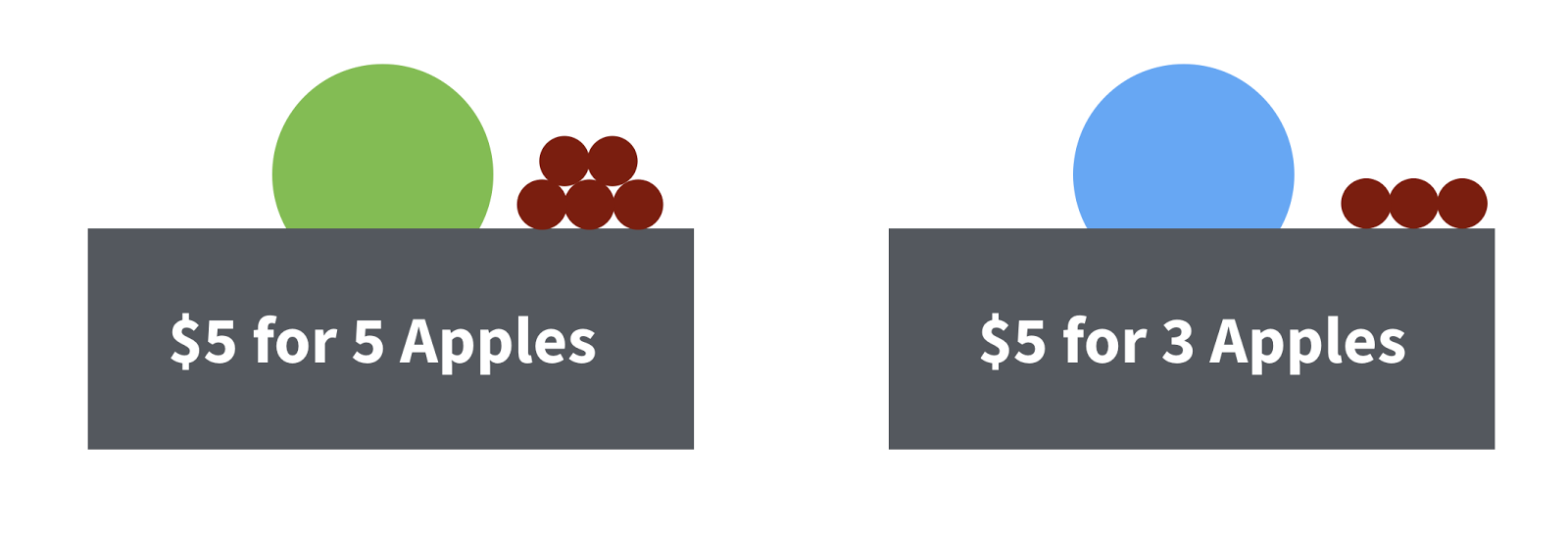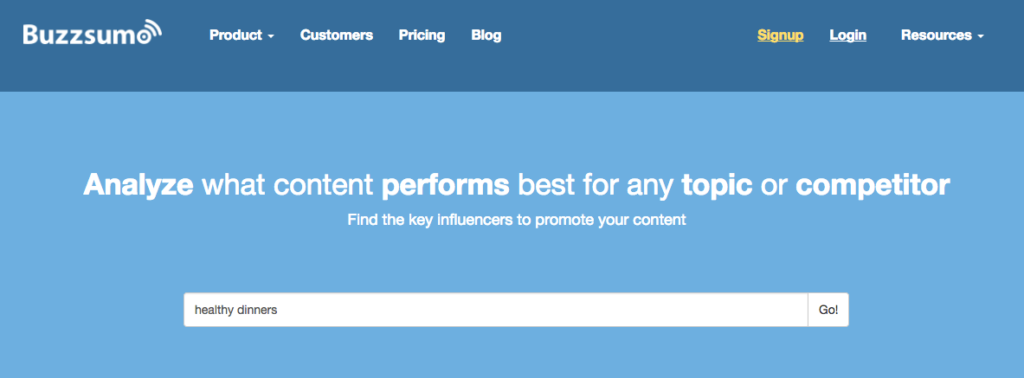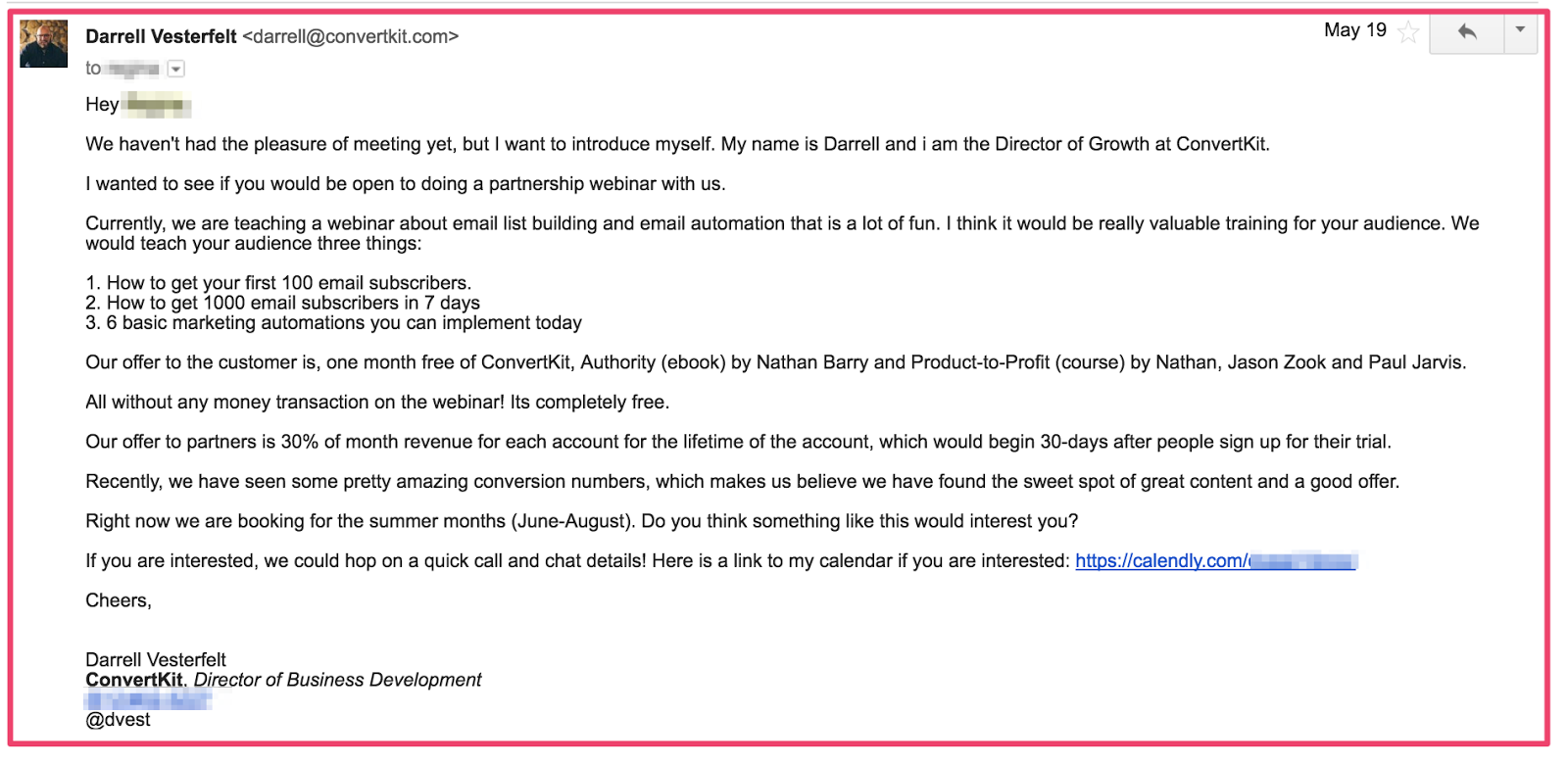You walk up to a fruit stand. Two people are selling apples.
Booth A has a basket of 5 apples and it costs $5.
Booth B has a basket of 3 apples and it costs $5.

Which one would you buy?
…
..
.
The last two weeks we’ve done an exhaustive review of two different email services, ConvertKit and Drip. But something interesting caught my eye about those two services and I want to pause our review series to share it today.
Drip has more features than ConvertKit.
But they cost practically the same.
If a product has better features and nearly identical pricing as a competitor, it seems like a foregone conclusion that everyone would buy the one with better features.
If that’s the case, then why has ConvertKit grown at an average of 25%+ per month for the last 24 months (source).

What gives? Why are more people buying ConvertKit?
In this week’s article you’ll find out the answer to that question. You’ll get a behind-the-scenes look at the lethal marketing strategy that has fueled ConvertKit’s success.
That strategy has been the #1 factor in revenue growing from a few thousand dollars a month…

…to over $6,000,000 in annual recurring revenue.

The 3 factors that have caused more people to buy ConvertKit
In my assessment, there are three primary factors in ConvertKit’s growth.
Factor #1: More Precise Target Market
ConvertKit is hyper-targeted on one specific demographic: professional bloggers. Drip is not focused on one specific market. From the start they have tried to sell to 4 different types of businesses.
1 focus vs 4 focuses.
1 focus wins almost every time.
ConvertKit…

Drip…

This has been a big deal for ConvertKit’s early growth.
It allowed them to stay hyper-focused in their marketing and feature set, while Drip tries to attract several different types of customers.
Factor #2: Simplicity of Feature Set
ConvertKit’s most talked-about feature, based on the 100+ survey results we collected, was the simplicity of using the software. Drip is a very powerful piece of software, but if on a scale of 1 to 10 ConvertKit is a 8/10 in simplicity, then Drip is a 5/10 in simplicity.
Drip is just harder to use for certain demographics.
This UX simplicity was intentional by ConvertKit. Many people in their target demo were frustrated by complicated tools like MailChimp and Infusionsoft, and ConvertKit solved that problem by keeping their app clutter-free and easy to use.
See the Drip and ConverKit tear downs for examples of this.
Factor #3. Focused Marketing Strategy
The third, and I think the biggest, factor in ConvertKit outpacing Drip in growth despite a smaller feature set and similar price is their marketing strategy.
And that’s what I want to spend our time on today.
ConvertKit found one marketing strategy that worked and they did it over and over and over again.
110 times.
That strategy = partner webinars.
What is a Partner Webinar and How Does It Work?
Before we jump into the details, let’s go over what a partner webinar is and how it works.
This is the basic gist…
1. Find someone with an audience of people who might buy your product.

2. Ask them to do a webinar with you.

3. On the webinar, teach stuff related to the topic of your product.

4. At the end of the webinar pitch your product

5. Split the profits with your partner.

It’s simple and works like a champ.
You don’t have to have an email list and you don’t have to be a big name. All you have to do is find someone with a relevant audience and ask them to partner with you. (Don’t worry, I’ll show you how in a second.)
Follow These 5 Steps to Host Your First Partner Webinar
There are 5 steps you need to follow to host a partner webinar.
Step #1: Find a partner.
Step #2: Pitch and book the partner.
Step #3: Create the offer you’ll sell on the webinar.
Step #4: Create and host the webinar.
Step #5: Send out a few emails so people show up and buy your stuff.
Let’s tackle these in order….
Step #1: How to Find a Partner For Your Webinar
The first step to hosting a partner webinar is finding a partner.
Here are the 3 action items to helping you find a partner.
Action Item #1: Start with your personal relationships.
The best place to start finding people to host partner webinars with is to look at your current relationships.
Who do you already know?
Who have you had contact with via email, phone, LinkedIn, or Facebook that you could ask to partner with you?
Who are the people who have linked to your site or mentioned you on social media?
Who are the people who have replied to your emails or complimented your work?
List the individuals who you already have personal relationships with who could be potential partners.
Action Item #2: Search through your current customers.
When ConvertKit started using partner webinars to grow their email list and user base, they started with their current customers. They looked to the people who were already using their product and who had a significant number (1,000+) of subscribers.
If you already have a product, service, or email list that has some influencers subscribed, this is a great place to start when trying to find partners for your webinar.
List the individuals who have purchased your products or services who could be potential partners.
Action Item #3: Search Google and BuzzSumo and reach out to key influencers.
You may already have a list of people who are influencers in your niche, but who do not sell the exact same product or service as you. If not, it’s time to make that list.
The best way to do this is to search for bloggers, course creators, and influencers who have a market similar to yours.
For instance, say you sell an online course about yoga.
You could reach out to people who talk about general wellness, nutrition, another form of exercise, diet, etc.
You have the same niche, but different offerings: This is a great potential partner.
To find the people who have a large influence, one good place to look is BuzzSumo.
Experiment with typing in a few different subjects that your niche may also be interested in.
For instance, if I type “healthy dinners” into BuzzSumo…

I get these results…

List the individuals who you identify as influencers from your research.
Step #2: Pitch and Book Your Partner
Once you have your list of potential partners, you need to pitch them on partnering with you.
Here are two examples of how ConvertKit pitched potential partners.
Example #1:

Example #2:

Once you receive interest back from a potential partner, the next step is to get on a call with them to go over the details and finalize the promotion itself.
Here are the 3 major things you are looking to lock down on that call…
- The date and time of the webinar
- The contributing item that the partner will add to the pitch (usually an info product of some sort)
- The promotion plan for the partner (email + social + ppc sequences)
And these are the 3 major things you want to make sure they know about the promo.
- What the offer on the webinar will be
- What the educational content on the webinar will be
- How commissions are structured and will be paid out.
Step #3: Create the Offer You’ll Sell on the Webinar
The next step in hosting your partner webinar is creating the offer that you will pitch to your webinar attendees.
Here are the 3 basic parts:
Part #1: Your product offer
Part #2: Partner bonus Item
Part #3: Live bonus for buying on the webinar
ConvertKit’s offer is one of the most unique that I have found.

Most webinars work like this:
1. Pay $X for the core product
2. Get Bonus #1
3. Get Bonus #2
4. Get Bonus #3
ConvertKit’s offer works fundamentally differently.
1. Pay nothing
2. Get 30 days of our service
3. Get Bonus #1
4. Get Bonus #2
5. Get Bonus #3
6. After 30 days, pay $29+ per month
The big difference is that there is no cost to get the webinar bundle. This produces extremely high sign-up rates on their webinars and gets people using the product.
According to self-reported numbers from ConvertKit, as many as 70% of live attendees sign up for this offer, and 60% of those users become paying customers.
Here are a few more offer slides from various webinars to give you other ideas for what your bundle could look like.
Dr Axe:

ClickFunnels:

LeadPages:

Michael Hyatt:

Mariah Coz:

Step #4: Create and Host the Webinar
The next major component is to create and host the actual webinar.
It’s easy to get bogged down in creating your webinar. Here is the framework that we use to put together our webinars.
Our webinar framework:
- Title slide (< 2 minutes)
- Introduction section (15 minutes)
- Introduce yourself (< 60 seconds)
- Introduce your big promise (1 minute)
- Housekeeping (< 3 minutes)
- Debunk the old framework (5 minutes)
- Introduce the new framework (5 minutes)
- Training section (15-30 minutes)
- Introduce training (1 minute)
- Tip #1 (5-10 minutes)
- Tip #2 (5-10 minutes)
- Tip #3 (5-10 minutes)
- Pitch section (20-30 minutes)
- Two options for moving forward (3 minutes)
- Introduce the product/service idea (5-10 minutes)
- Show the product/service idea (5-10 minutes)
- Show them the webinar deal (5-10 minutes)
- Closure (< 3 minutes)
Here is an example of this framework in action from a recent webinar:
ConvertKit uses a similar framework for their webinar.
Here is a webinar ConvertKit did a few months back:
https://www.youtube.com/watch?v=kvbFwbZuVas
Step #5: Send Out a Few Emails So People Show Up and Buy
The last major component to ConvertKit’s success with partner webinars is their email sequence.
There are two major phases to a good webinar email sequence…
Phase #1: Emails that get people to show up to the webinar
Phase #2: Emails that get people to buy after the webinar
Here is what those sequences look like at a high level…

The primary purpose of Phase #1 emails is to get people to attend the webinar. Remind them until it feels like you are bugging them or they will forget and not show up.
ConvertKit sends 3 emails the day of the webinar. We do the same.
We also recommend sending registrants a text messages 15-minutes before the workshop starts. 98% of text messages are opened within 5 minutes of being received… so it’s a great way to boost show-up rates.
We created Remind Them (a free tool), to help you collect phone numbers and send text messages. Check it out here.
Here is their 15-minutes-before email:

The primary purpose of Phase #2 emails is to get the people who didn’t watch the webinar to watch AND to get them to buy the offer.
Here is their replay email:

How to 2x your revenue in the next 30 days?
The partner webinar campaign that I just described is what ConvertKit has used to grow their business. It’s also one of the most effective sales and list building strategies that we’ve used at Videofruit.
Just this year we’ve hosted 3 partner webinars that have generated 4,500 new emails subscribers and $65,000 in sales.
What does that mean for you?
We just released the Partner Webinar Campaign in Slingshot.
The Partner Webinar Campaign will help you execute every step of the process we outlined in this post and will also give you tons of examples, swipe files and templates you need.
So, if you feel overwhelmed and not sure what to do next, your next step should be to grab a Slingshot Annual plan and follow the road map we lay out for you.
Note: In an earlier version of this article we inaccurately stated that Drip.co had a 10% growth rate over the past 24 months.